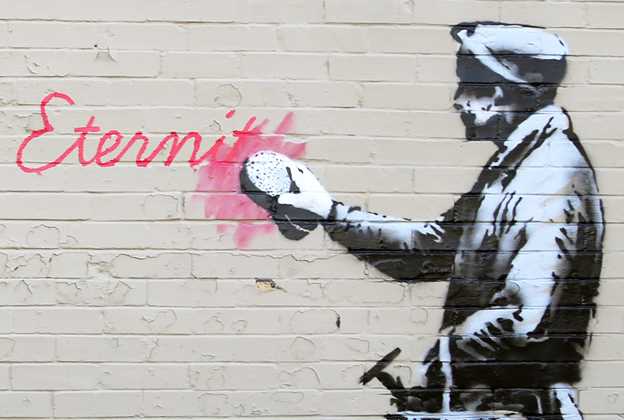When it comes to street art, one name that comes to mind is Banksy. With his thought-provoking and politically charged works, Banksy has become one of the most famous and mysterious artists in the world. His art can be found on the walls of buildings, bridges, and even the infamous West Bank barrier, sparking conversations and debates globally.
What sets Banksy apart from other artists is his anonymity. Despite being in the spotlight, the true identity of Banksy remains a well-kept secret. This anonymity adds to the mystique and allure surrounding his art, allowing the audience to focus solely on the message conveyed through his works.
One of the signature elements of Banksy’s art is his use of stencils. This technique not only allows him to create detailed and intricate designs but also enables him to work quickly and anonymously. His stenciled artworks often depict political and social issues, challenging the status quo and highlighting the injustices in society.
Banksy’s art is known for its satirical and humorous nature, using ironic visuals to convey a deeper meaning. He often incorporates elements of pop culture and familiar imagery to make his works relatable and accessible to a wide audience. This fusion of artistic skill, wit, and social commentary has made Banksy’s art resonate with people from all walks of life.
Whether it’s a rat wearing a CND sign or a little girl releasing a heart-shaped balloon, Banksy’s art captures the hearts and minds of those who encounter it. His works have the power to inspire people, provoke thought, and challenge societal norms. Banksy’s impact on the art world cannot be understated, and his legacy as the master of anonymous street art continues to grow with each thought-provoking piece he creates.
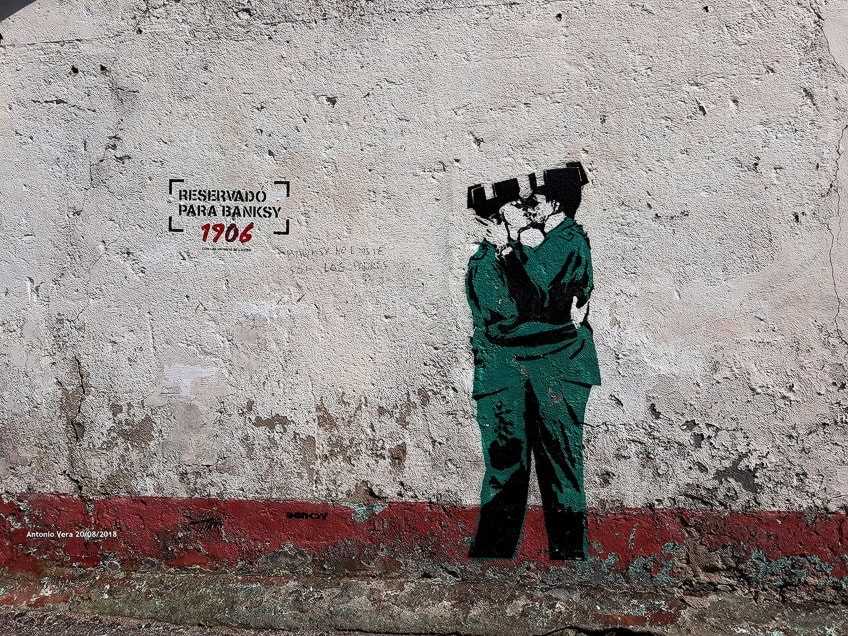
Banksy, the elusive street artist, was born in the late 1970s in Bristol, England. Very little is known about his early life, including his real name. Banksy’s anonymity has played a significant role in his art, allowing him to make powerful statements without personal recognition.
It is believed that Banksy’s interest in graffiti and street art began in the early 1990s. Inspired by the thriving local scene in Bristol, he started experimenting with stencils, which would become one of his signature techniques. Banksy’s early works often depicted rats, a symbol he used to represent the urban environment and rebellion.
By the late 1990s, Banksy’s artwork started to gain attention, catching the eye of both locals and art enthusiasts. His unique style, which blended social commentary with dark humor, quickly made him stand out within the street art community.
The early 2000s marked a turning point in Banksy’s career as he began to expand his reach beyond Bristol. He started creating art in major cities around the world, including London, Paris, and New York. Banksy’s clever and thought-provoking murals caught the media’s attention, leading to increased exposure and recognition.
Despite his growing popularity, Banksy remained determined to maintain his anonymity. He avoided interviews and public appearances, allowing his art to speak for itself. This element of mystery has only added to his allure and ensured that his work continues to captivate audiences globally.
Today, Banksy’s artwork is highly sought after by collectors and can be found in galleries and museums around the world. His bold and provocative pieces continue to challenge societal norms and spark conversations about a wide range of themes, including politics, consumerism, and the human condition.
The Stencil Technique
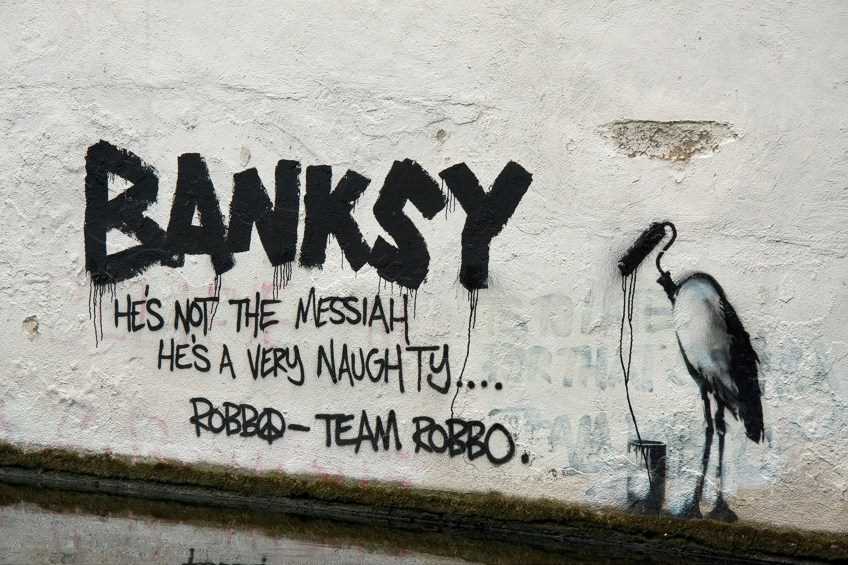
The stencil technique is one of Banksy’s signature styles when it comes to his street art. It involves using stencils, usually made of cardboard or plastic, to create precise and detailed images on walls, buildings, and other public surfaces.
With this technique, Banksy is able to quickly and efficiently create his artwork while remaining anonymous. Stencils allow him to replicate the same design multiple times, making it easier to leave his mark in different locations.
The stencil technique also allows Banksy to create intricate and complex images. By cutting out specific parts of the stencil, he can layer different colors and textures, adding depth to his artwork. This technique gives his pieces a realistic and visually striking quality.
Not only does the stencil technique help Banksy maintain his anonymity, but it also adds a layer of mystery and intrigue to his art. The use of stencils allows him to work quickly and discreetly, often in the middle of the night, further emphasizing his elusive persona.
Overall, the stencil technique is integral to Banksy’s style and has played a significant role in establishing him as one of the most influential street artists of our time.
Banksy’s Artistic Vision
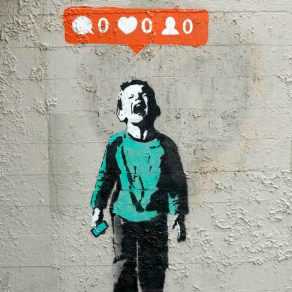
Banksy, the enigmatic and elusive street artist, has captivated audiences around the world with his thought-provoking and socially conscious art. His unique artistic vision challenges societal norms and raises awareness about important issues through his bold and often controversial works.
One of the distinctive aspects of Banksy’s artistic vision is his use of anonymity. Operating behind a mask of mystery, Banksy refuses to reveal his true identity, allowing his art to speak for itself. This anonymity adds to the intrigue and allure of his work, offering a sense of rebellion and defiance against the traditional art world.
Banksy’s art is characterized by its powerful and impactful imagery. He combines elements of stencil graffiti with clever slogans and striking visuals to create art that demands attention and leaves a lasting impression. His artworks often feature political commentary, challenging authority, capitalism, and social injustice.
The Use of Space
Banksy has a knack for utilizing his surroundings to enhance the meaning and impact of his artwork. Whether it’s painting on walls, bridges, or even buildings, he strategically selects locations that align with the message he wants to convey. By incorporating the existing environment into his art, Banksy creates a sense of context and relevance.
Subversion and Irony
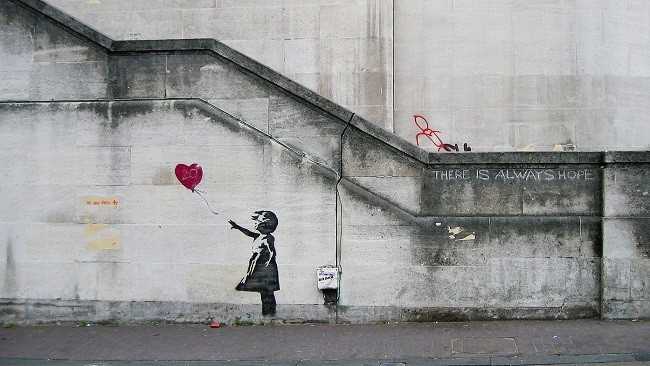
Banksy’s art is filled with subversive and ironic undertones. He challenges conventional notions of art and society by juxtaposing unexpected elements, such as a flower throwing a Molotov cocktail or a police officer hugging a rioter. This element of surprise and contradiction forces the viewer to reconsider their preconceived notions and prompts introspection.
| Artistic Vision | Key Features |
|---|---|
| Anonymity | Refuses to reveal true identity |
| Powerful Imagery | Combines stencil graffiti with bold visuals and slogans |
| Use of Space | Utilizes surroundings to enhance meaning |
| Subversion and Irony | Challenges conventional notions with unexpected elements |
Controversies Surrounding Banksy
Since the emergence of Banksy as a prominent street artist, there have been various controversies surrounding his work and identity. Here are some of the most notable:
The Elusive Identity
One of the biggest controversies surrounding Banksy is his anonymity. Despite being a globally recognized artist, Banksy has managed to keep his identity a secret. This has led to much speculation and debate about who he really is. Some argue that his anonymity adds to his mystique and allows his work to speak for itself, while others believe that artists should take responsibility and be accountable for their work.
Ownership of Street Art
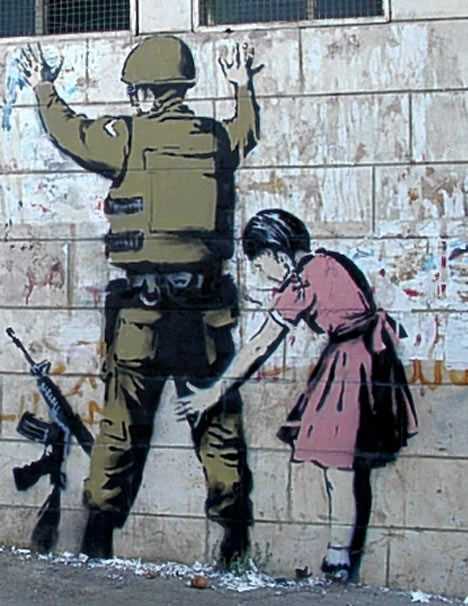
Another controversy surrounding Banksy revolves around the ownership of his street art. Many of his pieces are found on public property, such as walls and buildings, which raises questions about who has the right to own and sell these works. Some argue that street art should remain free and accessible to everyone, while others believe that it should be protected and monetized like any other form of art.
Furthermore, there are cases where Banksy’s street art has been removed or destroyed by property owners who consider it vandalism. This raises questions about the value and preservation of his work. Some argue that street art is ephemeral and should be accepted as a part of its urban environment, while others view it as an important cultural asset that should be protected.
The controversy surrounding the ownership and preservation of Banksy’s street art continues to spark debates and discussions within the art world and beyond.
Financial Implications
Banksy’s art has also been the subject of numerous financial controversies. His pieces have been known to fetch high prices at art auctions, with some selling for millions of dollars. However, this raises questions about the commercialization and commodification of his works.
On the one hand, some argue that by selling his art, Banksy undermines his status as a subversive street artist and risks becoming a part of the very system he critiques. On the other hand, others argue that selling his art allows him to gain financial independence and continue creating thought-provoking work.
Conclusion
The controversies surrounding Banksy are an integral part of his artistic persona. They reflect the complex nature of his work and the impact it has had on the art world. As Banksy continues to create and provoke, it is likely that more controversies will arise, further fueling the discussions and debates surrounding his unique brand of anonymous street art.
Banksy’s Influence on Urban Art
Banksy, the anonymous street artist known for his thought-provoking stencils and politically-charged artwork, has had a significant influence on urban art around the world.
Through his distinctive style and thought-provoking messages, Banksy has inspired a new generation of street artists to use public spaces as their canvas. His use of stencils allows for quick and efficient work, allowing artists to create large-scale murals in a short amount of time.
One of Banksy’s most notable contributions to urban art is his ability to communicate powerful messages through his artwork. His politically-charged pieces often tackle controversial topics, such as social inequality, capitalism, and war. By bringing these issues to the forefront of public spaces, Banksy encourages viewers to think critically and engage in important conversations.
In addition to his stencils, Banksy is also known for his unique use of irony and humor in his artwork. His pieces often incorporate playful elements that catch viewers off guard and force them to question societal norms and expectations. This use of irony has become a trademark of Banksy’s work and has influenced many other urban artists.
Banksy’s influence on urban art extends beyond his artwork itself. His mysterious persona and anonymous identity have added an element of intrigue and excitement to the art world. This anonymity has allowed Banksy to operate freely, navigating the streets and creating artwork without the confines of traditional art galleries or institutions.
Overall, Banksy’s influence on urban art is undeniable. His unique style, powerful messages, and mysterious persona have inspired a new generation of street artists and transformed public spaces into thought-provoking galleries. Banksy’s impact on urban art will continue to be felt for years to come.
The Global Hunt for Banksy
As one of the most elusive and mysterious artists of our time, Banksy has captured the imagination of people all around the world. His thought-provoking and politically charged street art has appeared in cities across the globe, from London to New York to Tokyo.
The hunt for Banksy has become a global phenomenon, with fans and art enthusiasts trying to uncover the identity of the anonymous artist. Many believe that Banksy’s work holds a deeper meaning and message, and his anonymity only adds to the intrigue.
There have been countless sightings and rumors about Banksy’s identity, but so far, he has managed to keep it a closely guarded secret. Various theories and speculations have arisen, with some suggesting that Banksy is a collective of artists working together, while others believe that he is an individual with a background in graffiti.
The Role of Social Media
Social media has played a significant role in fueling the hunt for Banksy. People share photos, videos, and stories of Banksy’s artwork on platforms like Instagram and Twitter, creating a virtual scavenger hunt for his pieces.
The global community of Banksy enthusiasts has also formed online, with forums and websites dedicated to tracking his art. These platforms serve as a way for fans to connect, share information, and discuss their theories about Banksy’s identity and motivations.
The Art of Disguise
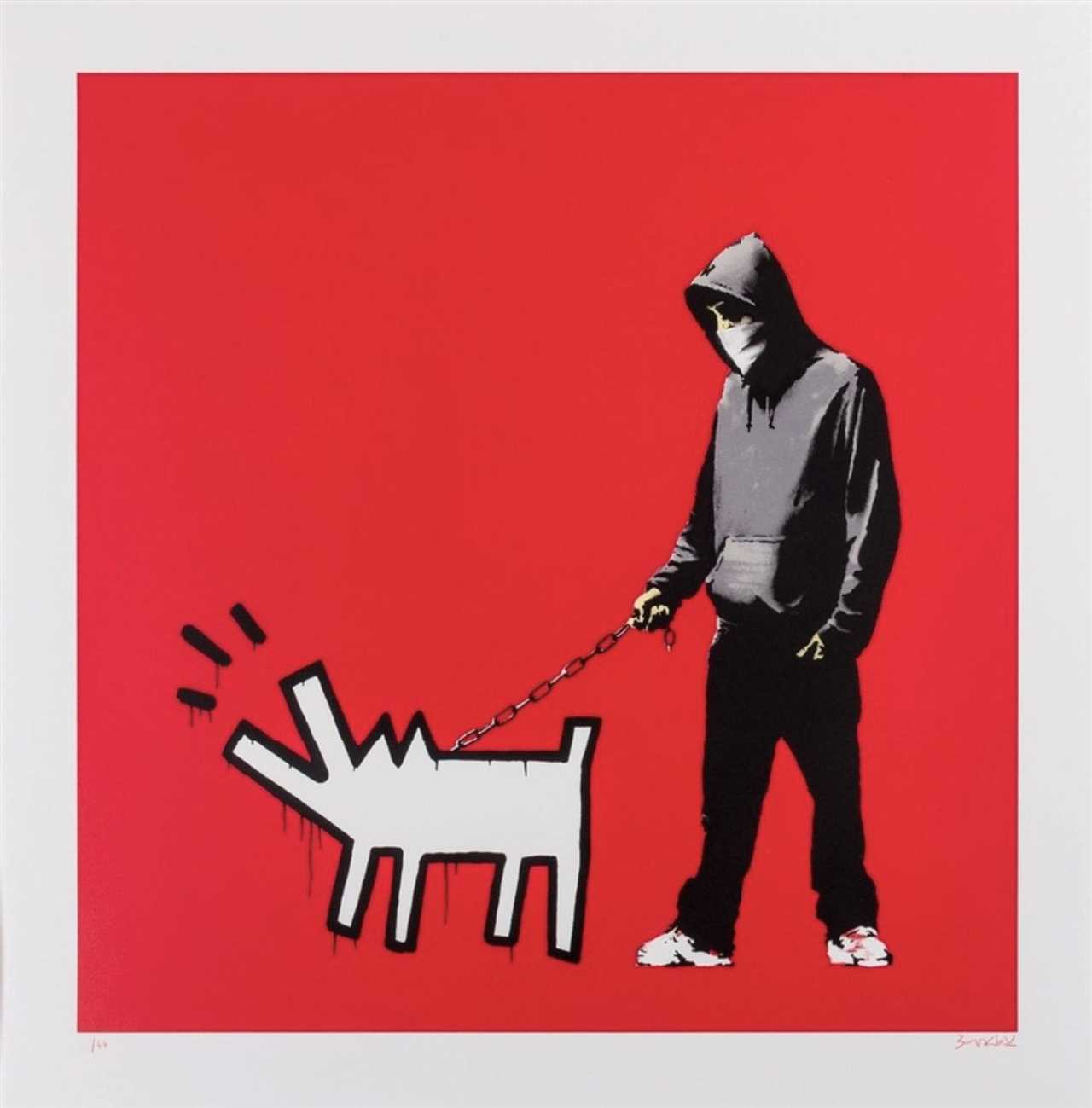
Banksy’s ability to remain anonymous is a testament to his skill as both an artist and a master of disguise. His street art often appears overnight, leaving no clues as to who created it. He uses stencils and spray paint to quickly tag walls and buildings, allowing him to work swiftly and avoid detection.
Furthermore, Banksy’s anonymity allows him to freely address controversial and sensitive topics in his artwork, without fear of persecution or reprisal. His anonymity serves as a shield, enabling him to push boundaries and challenge the status quo.
Banksy: The Legacy
Banksy’s impact on the world of art cannot be overstated. His distinctive style and thought-provoking messages have left a lasting legacy that transcends the boundaries of traditional art. Through his anonymous street art, Banksy has managed to challenge societal norms, ignite conversation, and inspire a new generation of artists.
One of the key elements of Banksy’s legacy is his ability to break down barriers. Street art was once considered vandalism, but Banksy has managed to elevate it to a respected art form. His works have been exhibited in prestigious galleries, and his name is mentioned alongside renowned artists. By blurring the lines between street art and traditional art, Banksy has opened doors for countless aspiring artists and changed the perception of what art can be.
Banksy’s art also carries a powerful social and political message. Many of his works tackle issues such as capitalism, consumerism, and political corruption. Through his provocative images and clever slogans, Banksy forces us to question our society and the world we live in. His art has the power to challenge the status quo and inspire us to seek change.
Furthermore, Banksy’s use of anonymity has also greatly contributed to his legacy. By remaining anonymous, Banksy has been able to focus solely on his art and message, without the distractions of fame and recognition. This secrecy has created an air of mystique and intrigue around him, making his art even more captivating and influential.
Banksy’s legacy is not only defined by his artistic achievements, but also by his philanthropic endeavors. He has used his art to raise awareness and funds for numerous charitable causes, ranging from humanitarian crises to environmental issues. Through his “Dismaland” project, he transformed a derelict theme park into an immersive art experience, with proceeds going to charities.

I am a mural enthusiast and a fervent admirer of street art. Rather than creating murals myself, I am passionate about collecting them. My love for street art knows no bounds. I am dedicated to curating and cherishing these artworks that grace the streets. My collection stands as a testament to my profound appreciation for this form of artistic expression.
read about me

